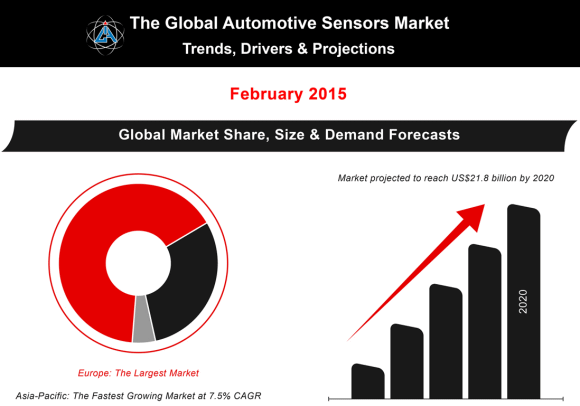
It's no secret that the Internet of Things (IoT) is now upon us and is rapidly transforming our daily lives. While the rise of smartphones, wearable technology, and other such devices has largely driven IoT growth, its true promise lies in shaping everyday experiences and creating new environments for data to be consumed, generated, shared, and processed. Particularly in the transportation industry, automotive serves as a burgeoning channel for IoT to take shape, especially as electronics and communication devices work their way into the structure of many new vehicle designs.
While sensors have historically played a role in some of these automotive technologies, their importance and value will only become more crucial as an enabler of the many networked connections we will see in the future. The actual connectivity of a vehicle to the internet has just begun. Today sensor-supported vehicle architecture allows limited key functions to be controllable from any place in the world, but the future will enhance these functions to merge mobility with IoT controlled networks.
A Look Back
Twenty years ago, the first yaw rate sensor based on MEMS was about the size of a smartphone and was only used in premium vehicles to increase active safety. Today, this technology has become standard with more than 50 sensors composing the modern vehicle's electronic architecture. That number is growing year-over-year as sensor performance improves and miniaturization occurs. In fact, Strategy Analytics predicts the market for automotive sensors will reach $24.1 billion by 2018.
Connected sensor technologies have played a key role in dramatically changing the driving experience. As sensors continue on an upward growth trajectory, manufacturers and suppliers should be cognizant of the following trends that will shape future automotive innovation:
-
Green standards and applications: New developments in vehicle systems have significant potential for fuel efficiency and engine management applications. For example, a double clutch transmission has 10% fuel savings compared to a conventional automated transmission. This is enabled by smarter technology that combines sensors and actuators into the drivetrain for improving efficiency.
-
Legal requirements for safety: Sensors have long been the technology behind most safety-relevant applications. This has evolved from pure passive systems like airbags and pre-crash safety towards active systems that assist in recognizing potentially dangerous traffic situations and deploy active collision-avoidance systems such as blind-spot detection, lane-keeping assistance, smart cruise control, adaptive headlights, tire-pressure monitoring, and more. Today, anti-lock braking systems and electronic stability control have become standard with next generation technologies such as advanced driver assistance systems being offered in premium and commercial vehicles.
- Comfort and entertainment: Perhaps the most visible benefits of sensors on the consumer driving experience stem from technologies such as keyless entry, temperature sensing, traffic sign recognition, and seat-memory functions. These applications lend themselves to improved quality of life and an overall enhanced driving experience.
Where Are We Going?
While sensors have incrementally transformed the driving experience, it will be the adoption of the driverless car that will allow sensors to reach their true potential. While it may seem many years away, the driverless car is no longer just a vision and has in fact become a reality with test vehicles already on our streets. Novelty aside, it is the next logical step in building a revolutionary vehicle from a safety and efficiency standpoint that will help eliminate critical human error in vehicle operation.

Fig. 1: Global market for automotive sensors will reach $21.8 billion by 2020.
As this technology evolves, those systems will have new requirements on their safety level, reliability and accuracy, however it is actually something the technology can cover today.
On the other side, OEMs must remember that driving is a passion for many. While technology can and should allow for autonomous functionality, it is important to provide options for manual operation as well. A truly innovative vehicle will let the driver decide how much they are willing to do themselves within the controlled environment of advanced driver assistance systems.
The Importance of Intelligent Design
Keeping these highly sophisticated sensor applications in mind, it will remain important for automotive sensor suppliers to have a strong understanding of what their products are being made for moving forward. For example, a position sensor for an automotive transmission application requires a different design and components than a sensor that identifies the brake pedal position. To combat this and to keep an intelligent design mindset, developers of these solutions are increasingly adopting simulation tools that are able to forecast the performance of position and speed sensors in any environment. This not only enables performance reliability but is also practical from an investment standpoint as they are able to adjust components, materials and dimensions to enhance and improve accuracy throughout the total measurement range.
Conclusion
There's no question that automotive innovation continues to thrive and sensor-based products will gain widespread adoption. As the market for these solutions grows, suppliers must remain vigilant in keeping in mind the end-user and IoT in their design and development process. The focus can no longer be solely on connecting things, in this case, a car, to the internet. Instead it's now about enhancing experiences to make these networked connections more relevant and valuable than ever before.
About the Author
Marcus Schulte is the Director of Global Engineering for Automotive at TE Connectivity Sensor Solutions. He is leading product and process engineering for a broad range of technologies on position, speed, and current sensors in automotive and commercial transportation vehicle applications. Prior to joining TE Connectivity, Marcus was head of a OEM focused development team at Siemens EC where he managed the strategic direction and development execution for the customer-specific development of vehicle connectivity. He holds a Master of Science in engineering from the Munich University of Applied Sciences and is the author of several publications around sensors and mechatronics in automotive applications.
Related Stories
Automotive MEMS Sensor Market Worth $3.60 Billion by 2020
Rear View Safety Proudly Debuts RVS-114 Sensor System
Image Sensors for a Smart Environment